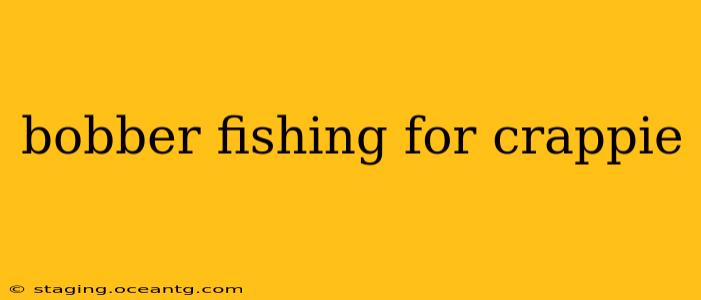Crappie fishing with a bobber is a popular and effective technique, especially for anglers targeting shallow water or targeting crappie suspended at various depths. This method offers a simple yet rewarding approach, perfect for beginners and seasoned anglers alike. This guide will delve into the intricacies of bobber fishing for crappie, covering everything from selecting the right gear to mastering effective techniques.
What is Bobber Fishing?
Bobber fishing, also known as float fishing, involves using a buoyant bobber to indicate a strike. The bobber floats on the water's surface, and when a crappie bites your bait, the bobber will dip, disappear, or twitch, signaling you to set the hook. This visual cue makes bobber fishing incredibly effective and enjoyable, particularly for anglers who prefer a more hands-off approach compared to other techniques like jigging.
Choosing the Right Bobber for Crappie Fishing
Selecting the appropriate bobber is crucial for success. The ideal bobber will depend on several factors, including water depth, current conditions, and bait size.
Types of Bobbers:
- Slip Bobbers: These bobbers slide freely up and down your fishing line, allowing you to adjust the bait's depth easily. This is particularly useful when targeting crappie at varying depths within the water column.
- Fixed Bobbers: These bobbers are fixed at a specific point on your line, maintaining a constant bait depth. They're great for shallow water fishing where you know the crappie are consistently at a certain level.
- Surface Bobbers: These are smaller and lighter bobbers that simply indicate a strike on the surface. Useful for very shallow water and targeting surface feeding crappie.
Bobber Size and Sensitivity:
The size and sensitivity of your bobber should correspond to your bait size and the conditions. Smaller, more sensitive bobbers are ideal for lighter baits and calmer waters. Larger bobbers are better suited for heavier baits and windy conditions.
Best Baits for Bobber Fishing Crappie
Crappie are opportunistic feeders, so a variety of baits can be effective. Here are some top choices:
- Minnows: Live minnows are a classic and highly effective bait for crappie. Their natural movements entice strikes.
- Worms: Small, lively worms, such as earthworms or red worms, are excellent choices.
- Jigs: Small jigs tipped with a minnow or plastic grub can be very effective, especially for targeting crappie suspended in the water column.
- Grubs: Plastic grubs are versatile and durable, coming in a variety of colors and sizes to match crappie's preferences.
How to Rig Your Line for Bobber Fishing Crappie
A simple yet effective setup involves the following:
- Line: Use a lightweight monofilament line, typically 4-8 pound test.
- Bobber Stop (for slip bobbers): A small bead or bobber stop prevents the bobber from sliding down to your hook.
- Slip Bobber (or Fixed Bobber): Select the appropriate bobber based on your fishing conditions.
- Swivel: A swivel prevents line twist.
- Hook: Use a small, lightweight hook appropriate for your bait.
Effective Techniques for Bobber Fishing Crappie
Success depends on understanding crappie behavior and employing effective techniques.
Targeting Depth:
Understanding the depth at which crappie are holding is crucial. Use a depth finder or sonar to locate crappie before casting. Adjust your bobber's position to target the identified depth.
Bait Presentation:
Present your bait naturally. Avoid aggressive retrieves; a slow, subtle drift is often most effective.
What are the best times of day to bobber fish for crappie?
The best times to bobber fish for crappie often coincide with periods of low light, such as dawn and dusk. During these times, crappie are more active and easier to catch. However, they can be caught throughout the day, especially if you locate them in favorable habitat.
What is the best depth to fish for crappie using a bobber?
Crappie can be found at various depths depending on the season, water temperature, and other environmental factors. In general, you can find crappie in shallower waters during the spring and fall, while they may move to deeper waters during the summer months. Using a depth finder is recommended to pinpoint the exact depth.
What type of water is best for bobber fishing crappie?
Crappie prefer clear water with ample structure such as submerged vegetation, brush piles, docks, and fallen trees. These structures offer cover and ambush points for crappie.
Conclusion
Bobber fishing for crappie is a versatile and rewarding technique that can lead to exciting catches. By understanding the factors involved—choosing the right gear, selecting appropriate baits, and mastering effective techniques—you can significantly increase your success rate and enjoy hours of productive and enjoyable fishing. Remember to practice responsible angling techniques and respect the environment.
